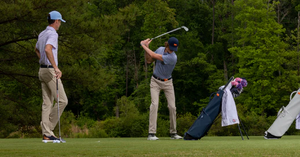How To Drive a Golf Ball
Embarking on a successful round of golf hinges on one's ability to master the art of driving. The skill of propelling the ball off the tee with accuracy, distance, and consistency is paramount for golfers of all levels. We've got you covered.
This comprehensive guide delves into the intricacies of driving, exploring fundamental techniques, the unique challenges the driver poses, and a step-by-step approach to executing a flawless golf drive. This guide aims to equip enthusiasts with the knowledge and tips to elevate their performance off the tee.
The Importance of Driving a Golf Ball Well
For several reasons, driving a golf ball well is paramount for golfers, significantly influencing overall performance and scores. Firstly, a well-executed drive provides a distinct distance advantage. A ball struck accurately and powerfully covers more ground, offering a considerable edge, especially on longer holes. This advantage translates to a shorter approach shot to the green, setting the stage for increased scoring opportunities.
Moreover, driving proficiency plays a crucial role in effective course management. Accurate and long drives empower golfers to navigate the course strategically. A successful drive positions the player for a more controlled second shot, enhancing the likelihood of landing the ball closer to the pin.
The impact extends beyond the tactical aspects of the game. Confidence is a pivotal aspect of golf, and success with the driver contributes significantly to a golfer's positive mindset throughout the round. Knowing that one can consistently hit the fairway and gain distance off the tee fosters a sense of self-assurance.
Additionally, the opening shot of each hole is typically a drive, making it a critical moment to set a positive tone for the entire hole and, consequently, the round. Conversely, struggling off the tee can lead to frustration, potentially impacting subsequent shots and overall performance.
Driving proficiency also reduces the difficulty of approaching shots. A well-executed drive often results in a more favorable lie, enabling golfers to come subsequent shots from the fairway rather than dealing with the challenges of the rough or hazards. This execution contributes to better control over the trajectory and spin of the ball.
In competitive formats such as match play or team events, consistently outdriving opponents applies psychological pressure. Opponents may feel compelled to take risks or play more aggressively, increasing the likelihood of mistakes.
What Makes a Driver Harder To Hit Than Other Clubs?
Several factors make a driver more challenging to hit than other clubs in a golfer's bag, especially as a beginner. One key aspect is the minimal loft of drivers compared to other clubs. While irons have varying degrees of loft that facilitate getting the ball airborne quickly, drivers typically feature around 9 to 12 degrees of loft. This scarcity of loft necessitates golfers to generate ample lift on their own, and any mishit can result in a loss of both distance and accuracy.
Moreover, the length of drivers presents another challenge. With a standard length of around 45.5 inches, drivers are notably longer than shorter irons like a sand wedge, which might be approximately 35.25 inches. The extended length requires a more expansive swing, making it crucial for golfers to maintain control throughout the swing.
Additionally, drivers offer limited forgiveness despite their larger clubheads designed for distance. Like hitting the ball toward the toe or heel, mishits can significantly lose accuracy and distance. In contrast, smaller-headed clubs like irons often provide more forgiveness on off-center hits.
Lower spin is another characteristic of drivers. While this is advantageous for maximizing distance off the tee, it also means that any sidespin resulting from a mishit can be exaggerated, leading to slices or hooks. Tee height and setup become critical factors, with drivers exclusively hitting off a tee. Incorrect tee height or setup can result in issues like hitting down on the ball, causing pop-ups, or topped shots.
Moreover, the tendency of many golfers to swing their drivers faster than their other clubs adds to the complexity. This desire to maximize distance introduces the challenge of maintaining control and proper mechanics, making losing accuracy with the driver easier.
How Do You Properly Drive a Golf Ball?
Begin by Ensuring the Correct Ball Position
Place the golf ball forward in your stance, near the inside of your lead heel. For right-handed golfers, this would be the left heel. This position facilitates an upswing contact, maximizing distance and optimizing launch conditions.
Adjust the tee height so that approximately half the ball is above the top of the clubhead at the address. Experiment with tee height to find what works best for your swing and maximizes your chances of hitting the sweet spot.
Experiment With the Width of Your Stance
While a wider stance is common for driving, find a comfortable width and allow for stability, balance, and a complete turn. Additionally, incorporate a slight shoulder or spine tilt into your setup. This tilt helps promote an upward strike on the ball, increasing the launch angle and reducing any backspin.
Ensure That Your feet, Hips, and Shoulders Parallel Your Target Line
Misalignment can lead to unwanted ball flights, so take the time to check your setup regularly. Turn your feet outward to allow for better hip rotation during the backswing and follow-through, contributing to more power.
Focus on a Smooth Takeaway
The longer driver shaft often tempts golfers to rush the backswing. Maintain a controlled tempo throughout your swing, as a smooth and rhythmic swing often leads to better contact. Complete your swing with a balanced finish, holding your position until you see where the ball is heading. A flat finish indicates good weight transfer during the swing and is crucial for consistency.
Incorporate Purposeful Practice
Use drills like the three-tee drill, where tees are placed on either side of the ball to ensure center-face contact. Utilize feedback tools, such as foot spray on the clubface, to identify where you're making contact.
Get a Professional Club Fitting
Club fittings are personalized to your body type, including height, shape, and ability. Store-bought clubs are typically mass-produced, offering a one-size-fits-all solution.
Block Out Distractions and Stress
Maintaining focus is essential. Block out external distractions and stress by adopting a pre-shot routine. Visualize your intended shot, take a deep breath, and step into the swing with a clear mind.
Get Rid of Tension in Your Swing
Tension in your muscles can hinder your swing's fluidity. Prioritize a relaxed grip and overall posture. A smooth, tension-free swing contributes to better clubhead speed and improved contact with the ball.
Maintain a Positive Mindset
Golf is as much a mental game as it is physical. Cultivate a positive mindset, especially during challenging rounds. Visualize successful shots and approach each drive with confidence.
Utilize Swing Aids and Training Aids
Leverage technology and training aids to refine your technique. Video analysis, launch monitors, and swing trainers can provide valuable insights into your swing mechanics, helping you identify areas for improvement.
Experiment with Shot Shaping
Develop the ability to shape your shots. While consistency is crucial, having the skill to shape your drives intentionally—whether a fade or draw—adds versatility to your game and helps you navigate different course layouts.
Frequently Asked Questions
Why Can't I Hit My Driver Properly?
Struggling with the driver in golf can stem from common issues like inconsistent swing mechanics, improper ball position or tee height, ill-fitted equipment, mental obstacles, and a lack of practice. Focus on swing consistency, correct ball position, and mental composure, and seek professional guidance for improved driver performance if problems persist.
How Far Should You Stand From the Ball When Driving?
The optimal distance from the ball when driving in golf depends on various factors, including your height, the length of your clubs, and personal preferences. A general guideline is to stand far enough to allow a slight bend in your arms, ensuring comfort and the ability to execute a balanced and powerful swing.
Final Thoughts
Mastering the art of driving in golf is not merely a technical skill but a strategic advantage that profoundly influences overall performance. A well-executed drive provides a significant distance advantage, setting the stage for shorter approach shots and increased scoring opportunities. Beyond tactical advantages, shop for expertly designed golf gear and apparel with Stitch Golf to improve your performance further.



